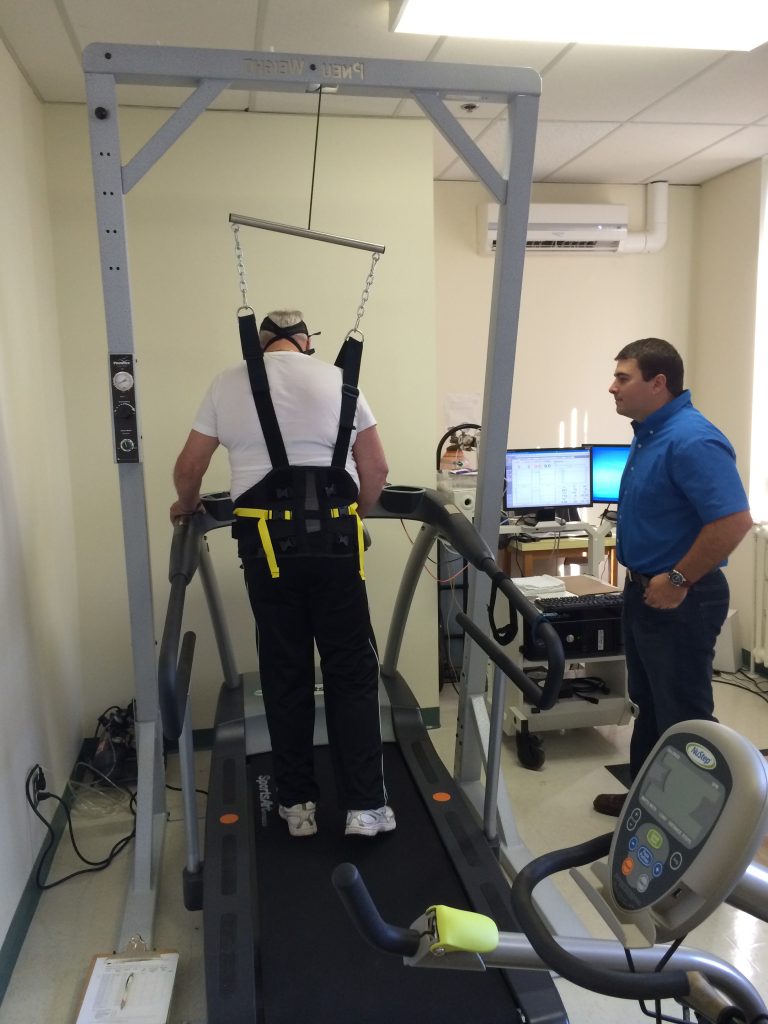Fluid intelligence, sometimes called abstract reasoning, is the ability to think logically and solve problems; a highly valued human capacity. Over 70% of patients admitted to hospital with stroke have cognitive impairment, but cognition is rarely a target of rehabilitation treatments.
Moderate-vigorous intensity aerobic exercise is a potent brain stimulus that increases brain blood flow and enhances neurotransmitters and neurotrophins that directly impact the signaling of neurones (Ploughman & Kelly, 2016). Thus, aerobic exercise may help to improve cognitive impairment after stroke.
In our recent study, we wanted to determine if adding aerobic exercise to computerised working memory training could ‘prime’ the brain and enhance fluid intelligence in people with chronic stroke-related cognitive impairments. We also investigated the relationship between changes in serum levels of neurotrophins – brain-derived neurotrophic factor (BDNF) and insulin-like growth factor (IGF-1) – and the degree of cognitive improvement (Ploughman et al, 2015; King et al, 2019).

Sixty people with chronic stroke were randomised to one of four groups. Each group received physical training (vigorous or low intensity) followed by computerised cognitive training (working memory training or games) three times per week for 10 weeks. Group 1 received 30 minutes of vigorous aerobic exercise on a treadmill, with a harness for safety, followed by 30 minutes of dual-n-back working memory training on a computer. Group 2 received the same type of aerobic training but the cognitive training was a non-adaptive computer game with descending puzzle pieces. Group 3 received lower intensity functional task practice (Kelly et al, 2017) followed by the working memory training. Group 4 received functional task practice followed by computerised games. Participants were assessed before, directly after, and 12 weeks after training. As our aim was to improve cognition in the longer term, our main outcome was the persistence of benefits, if any, at 12-week follow-up.
WHAT DID WE FIND?
Vigorous aerobic exercise without cognitive training did not improve fluid intelligence. However, pairing vigorous aerobic exercise with computerised working memory training resulted in an almost 50% improvement in fluid intelligence. Exercise-induced increases in serum IGF-1, but not BDNF, were correlated with the improvements in fluid intelligence. Participants in the vigorous aerobic exercise groups also improved their fitness and walking speed.
SIGNIFICANCE AND IMPLICATIONS
This study showed that using vigorous intensity aerobic exercise to ‘prime’ the brain increased the potency of cognitive therapy (computerised dual-n-back working memory training). Furthermore, this combined intervention not only broke though the recovery plateau (i.e., the lack of additional improvement that occurs during stroke recovery), but also improved chronic stroke impairments in multiple domains (cognition, walking and fitness). The results of this study add practical tools to therapist’s treatment arsenal and warrant testing in other neurological disorders such as multiple sclerosis (Ploughman 2017).
PUBLICATION REFERENCE
Ploughman M, Eskes GA, Kelly LP, Kirkland MC, Devasahayam AJ, Wallack EM, et al. (2019). Synergistic Benefits of Combined Aerobic and Cognitive Training on Fluid Intelligence and the Role of IGF-1 in Chronic Stroke. Neurorehabil Neural Repair, 33(3): 199-212.
If you cannot access the paper, please click here to request a copy.KEY REFERENCES
Kelly LP, Devasahayam AJ, Chaves AR, Wallack EM, McCarthy J, Basset FA, et al. (2017). Intensifying functional task practice to meet aerobic training guidelines in stroke survivors. Front Physiol, 8:809, doi: 10.3389/fphys.2017.00809
King M, Kelly LP, Wallack E, Hasan SMM, Kirkland MC, Chatterjee T, et al. (2019). Serum levels of Insulin-Like Growth Factor-1 and Brain Derived Neurotrophic Factor as potential recovery biomarkers in stroke. Neurol Res, 41(4): 354-363.
Ploughman M. A new era of multiple sclerosis rehabilitation: lessons from stroke. (2017). Lancet Neurol, 16(10):768-769.
Ploughman M & Kelly LP. (2016). Four birds with one stone? Reparative, Neuroplastic, Cardiorespiratory and Metabolic Benefits of Aerobic Exercise Post-stroke. Curr Opin Neurol, 29(6): 684-692
Ploughman M, Austin, MW, Glynn L & Corbett, D. (2015). The effects of poststroke aerobic exercise on neuroplasticity: a systematic review of animal and clinical studies. Transl Stroke Res, 6(1):13-28.
AUTHOR BIO
Michelle Ploughman is an Assistant Professor at the Faculty of Medicine at Memorial University and Canada Research Chair (Tier II) in Rehabilitation, Neuroplasticity, and Brain Recovery. You can learn more about her research here: https://www.med.mun.ca/RRUNL/Recovery-and-Performance-Laboratory.aspx
